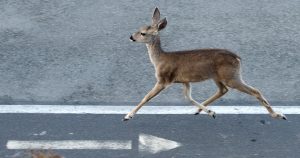
Wrong Way Fawn
There were 1.33 million collisions with deer on America’s roads from July 1, 2017, to June 30, 2018, according to the Insurance Information Institute. In 2016, this type of incident resulted in 189 human deaths, many thousands of injuries, and around $3.6 billion in vehicle repair costs.
The state with the highest likelihood of colliding with a deer in West Virginia where one in 46 drivers will be involved. Hawaii has odds of one in 6,379 making it the least likely spot for encountering deer on the roads. The state of New York ranks 26th with more than 70,000 deer collisions every year.
There’s not a lot you can do when a deer leaps out right in front of you, but these six tips might help you to avoid a collision, or at least minimize the damage.
1. Be Aware
Deer Crossing signs are placed on stretches of road with a particularly high incidence of deer collisions, but any country or forest road has the risk. Slow down in these areas and be on the lookout for deer in the fields or at the forest edges. If you see a deer, assume that it will cross and be prepared to stop.
2. Blow Your Horn
If you spot a deer by the side of the road, slow down and blow your horn repeatedly. The animal will detect a threat and hopefully move away from the road. But pass slowly as the deer is unpredictable and may decide to cross anyway.
3. Use High Beams
When you are driving at night, often the first sign of a deer is the reflection of your headlights in its eyes. Using your high beams can give you the best chance of spotting the risk. However, your lights may confuse the deer and are unlikely to deter it from crossing in front of you, so slow down.
4. Watch Out for More
Deer are herd animals and rarely travel alone. If you see a deer cross the road in front of you, slow right down because the odds are that more will follow. This is a bigger risk during the mating season as a doe may be trying to escape the attention of several bucks which will be following her.
5. Stay in the Center
When you’re on a multi-lane road, driving in the center lane gives you the best chance of reacting if you see a deer about to cross.
6. Don’t Swerve
Despite your vigilance, if a deer jumps in front of your car and a collision is unavoidable, brake firmly but do not swerve. Sure, hitting a deer is going to damage your car, but trying to avoid it by swerving onto the shoulder or into oncoming traffic puts you at a bigger risk.
Most accidents involving deer happen during the rutting season from October to December, peaking in November, when the movement of deer tends to be more random. You can encounter deer at any time of day or night, but dawn and dusk are the most dangerous times. Although you never know when a deer might cross your path, these six tips can help you stay prepared on the road.
“Wrong Way Faun” via Flickr by Don DeBold. Used with permission via CC BY 2.0 / cropped from original



